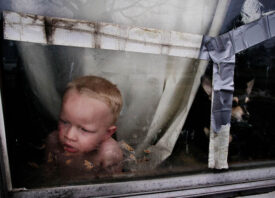Search this site
The Joys and Heartache of Family Life, in Photos


“This series of images represents a phase in my life,” the photographer Matt Eich says of his book I Love You, I’m Leaving. “Not a pleasant one, but an important one.” He created these photographs with friends and family during the two-year span between 2015 and 2017, a period marked by change, including a move for his immediate family and the separation of his parents. An exhibition of the work opens in December at Cassilhaus in Chapel Hill, NC.
I Love You, I’m Leaving spans generations of the artist’s family: his mother and father, himself and his wife, their daughters. Memories of grandparents also play a significant role in the work; as a child, Eich’s interest in photography first blossomed during his grandmother’s struggle with Alzheimer’s. His grandfather, who gave him his first point-and-shoot camera, passed away the same year the project ended; in the final photograph in the volume, a color image after the book’s acknowledgements, we find Eich’s daughter sitting beside his casket.
The only text in the book, save for the title and the acknowledgements, is a brief love poem. Eich wrote it one morning after saying goodbye to his wife and driving to Ohio for an exhibition. It was the ten-year anniversary of the day they were married. “If it is about anything, it’s about being torn between the desire to be with the one you love, and the knowledge that you must constantly leave,” Eich admits, and in many ways, that idea forms the backbone of the book as a whole.
It’s worth noting, I think, that the photographer chooses a comma instead of a period or a semi-colon between “I Love You” and “I’m Leaving.” That is, they are not separate or distinct thoughts. In these pages, loving and leaving are two sides of the same coin, and being close to someone also means feeling that they are unreachable. Loved ones appear through windows and doors; sometimes, they turn their backs. Eich dedicates I Love You, I’m Leaving to someone who is both near-at-hand and faraway: his grandfather, whose loss is still new and fresh. The artist admits, “He never seemed to understand me, or what I was trying to do with a camera, but he was supportive all the same.” We asked him a few more questions about the series in anticipation of the exhibition at Cassihaus.

Has your wife and children’s relationship with the camera changed at all over time?
“My wife and children are incredibly understanding and supportive of my photographic compulsions. That said, there are times when they will say, ‘Not now. Put down the camera,’ and I need to hear that and respect it. My oldest daughter went through a phase where she was sort of over the camera, around age six, but I see an increasing understanding from her in what it is I am trying to do and make. My youngest will frequently pop into my studio and peer over my shoulder or plop on my lap and then begin interrogating me, ‘Who is this? What is that? What is that person doing?’ She’s very interested and engaged, but it’s harder to catch her standing still.”

How do members of your family respond to these images?
“I don’t think that my children understand the emotional weight the work seeks to convey. To them, it’s just pictures of people they know for the most part. One of my favorite photographs, Dissolution, Charlottesville, Virginia is of my parents sitting next to one another on a bench in my backyard, framed by a bubble. In it, my dad appears to be engaged, and my mother withdrawn, pulling away from him while on the phone.
“Recently I gave an artist talk, and my mother was in attendance, and we discussed this image afterwards–how the image can be misleading by showing her as less engaged. She is definitely an engaged and active family member, so the image doesn’t necessarily show that. Each individual has a reality that they carry into the reading of a photograph. Sometimes the photograph reaffirms our reality, sometimes it punctures it.”

In what ways is this book fictional? How and when does it become something different from your real life?
“The book is fictional in that not all of the images are straight documentary and some of the photographs are staged narrative. These photographs mostly depict my immediate family (father, mother, sisters, brother, wife, daughters), but there are a couple other characters who weave their way in. They are friends who function as stand-ins for other relationships. Also, I want for the images to be ambiguous and open-ended enough that the viewer can bring their own experience and interpretation to the reading of the image.”


Why black and white for this one?
“This work was made during graduate school, where I was struggling to develop a new way of speaking visually. One professor offered the advice, ‘If something is working for you, strip it away.’ Since early on, my projects have been in color, with a 35mm digital camera. For this work, I began making 6×7 B&W, sometimes locking the camera down on a tripod and placing myself into the picture. It required pushing myself out of my comfort zone, a lot of experimentation, and a lot of failure. Eventually though, I started to find patterns in the work, images that would sing together. Over time, a structure begins to emerge.”

How do you think your relationship with this book will change as time passes? What do you hope to find in its pages when you look back at them, decades from now?
“This is a good question, and I honestly don’t know how I will view this work in ten years. Hopefully I can look back on the book and think, ‘Wow, what a chaotic time. I’m glad life has settled out since then.’ But in reality, life will always be chaotic, and I may look back on this really stressful period of time with nostalgia, forgetting some of the more traumatic experiences and emotions of the period. I hope that one day my children will have the work to look at, and will know, beyond the shadow of a doubt, that they were (and are) deeply loved.”


All images © Matt Eich



